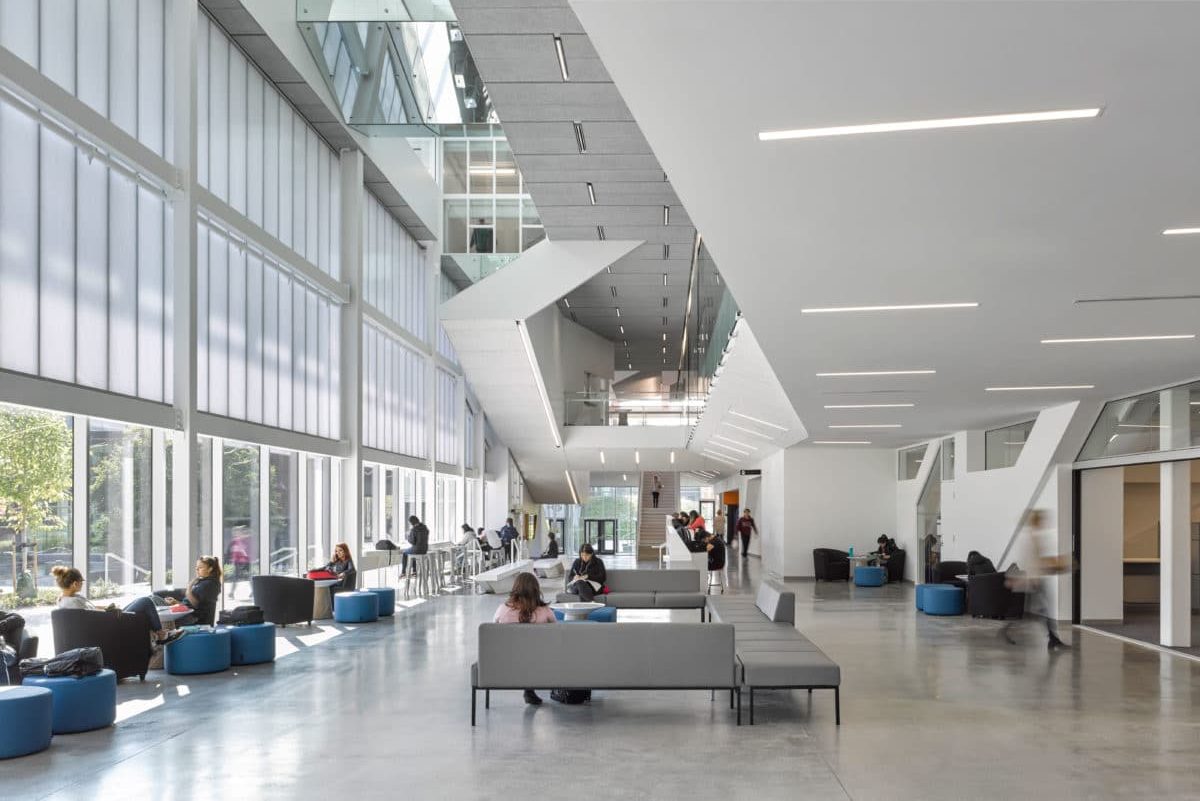Story at a glance:
- Daylighting infuses positivity and productivity, while reducing energy use in artificial lighting.
- Daylighting uses sustainable strategies to reduce the negative impact of sunlight, including heat gain and glare.
- Inviting natural light can also help with passive heating and cooling.
Welcoming light into buildings diminishes the need for artificial lighting during the day and creates a positive working atmosphere for productivity and uplifted spirits. With the implementation of the right technologies for the space, daylighting is significantly cost-effective and a sustainable and uplifting choice for lighting.
“When light is introduced to seemingly float a roof, dematerialize a corner, or flow through the interstices between elements, these details serve to open and release traditional spatial enclosure. As a consequence, details of light can imbue freedom, stimulate self-reflection, and empower people,” Christine Bruckner, director of M. Moser Associates, told gb&d.
Successful daylighting revolves around realizing the potential of a building and its setting and designing solutions that work for that particular space, making daylighting design a complex set of decisions that affect aesthetics, experience, and cost, as Marti Hoffer of lumenomics mapped out for gb&d.
Beginning with the design of the building footprint, it is important to take into consideration how the angle of the sun changes throughout the day to determine the location and spacing of windows with maximized south and north exposures. Window treatments and technologies, from high-performing fiberglass windows to daylight-responsive electric lighting controls, then work together to create a healthier space for occupants with ample natural light and, oftentimes, passive heating and cooling.
Here we explore more of the details around daylighting.
What is Daylighting?
Daylighting is the controlled admission of natural light, direct sunlight, and diffused skylight into a building to reduce electric lighting and saving energy. Scientists at the Lighting Research Center have reported that quality exposure to daylight (as a source of interior illumination) results in improved occupant comfort, mood, and productivity and decreased stress and rates of depression. It also provides the mental and visual stimulation necessary to regulate human circadian rhythms and the production of neural transmitters like serotonin.
The Main Advantages of Daylighting
Exposure to natural light has been proven time and again to have numerous benefits for people, according to architects at Perkins&Will. Benefits range from visual comfort to psychological and neurological benefits like improving mood, reducing stress, enhancing the body’s immune response, and allowing for better sleep.
- Improved mood
- Less fatigue
- Reduced eyestrain
- Energy savings
- Reduced greenhouse gas emissions
- Increased worker productivity
- Quicker recovery in health care setting
The Main Disadvantages of Daylighting
However, natural light does require thoughtful planning upfront. Improper management of light—i.e. understanding that daylight is more than a simple window or skylight—can lead to downsides, like glare.
KLA and Solatube are in the business of managing daylight. But there’s also such a thing as too much natural light.
“We’ve all been in a room with tons of glass windows, where no one sits in this one spot where all the heat is going. It’s about using glass in the appropriate places,” says David Gregory, senior architectural support specialist at Kingspan Light + Air (KLA) and Solatube International. “It’s about managing the daylight in such a way so you maximize the natural light you bring into the building without sacrificing that space for it.”
Here are some of the top disadvantages of daylighting.
- Improper management leading to glare
- Excess heat
- Unwanted shadows
- Difficult to control
Common Ways to Introduce Daylight into Buildings
Architects at Perkins&Will emphasize the need to consider how to use daylight in a meaningful way to artfully illuminate architecture in a fun and compelling way for occupants while also meeting the visual requirements to ensure people can use the space effectively and be happy doing so. Some common ways to bring daylight into the home, for example, beyond windows and skylights, include:
- Clerestory windows
- Solar tubes
- Light shelves
Introduction to Daylight Systems
Daylighting systems harvest natural lighting and automatically adjust electric lighting based on the amount of ambient light, according to bizenergyadvisor.com. Thoughtful daylighting systems give occupants control over how much light and when they get it, improving their health and mood.
Tubular Daylight
Some of the most popular tubular daylighting devices, also known as TDDs, are Solatube’s Daylighting Systems. These deliver the maximum amount of natural light into the home. They are also easy to install, with no major modifications needed to the attic or roof. You can choose from Solatube’s sunlight-capturing dome, reflective tubes, or others. Their Maximize Light Capture with Raybender 3000 Technology and the LightTracker Reflector is an innovative example, as its daylight-catching dome and integrated reflector combine to bring in an amazing amount of light from any angle, throughout the day and the year.
Vertical Systems
Similar to TDDs, vertical daylighting systems use a powered tracking system to point a light collector toward the sun. A series of mirrors and lenses concentrate the light before directing it into distributing tubes. The vertical system allows for a lot more light to be collected, and it can deliver that light up to seven times deeper into a building than compared to a TDD. That said, vertical systems do require modification to the roof.
Horizontal Systems
According to ScienceDirect, horizontal systems ensure efficient light distribution, maximum uniformity, and minimal glare. This system uses a light collector outside a building’s vertical facade. The system is configured to the exact characteristics of each building (facade orientation, latitude, and longitude) to optimize performance.
Fibre optical
Fiber optic daylighting systems include a collector, reflectors, filters, lenses to direct light to the fiber optic cables and a fixture to distribute the light. The daylight is gathered and concentrated by collectors using parabolic mirrors or Fresnel lenses that track the sun as it moves through the sky.
Real-Life Examples of Daylighting
These six commercial buildings each use daylight in innovative ways that suit their particular purpose and character, from municipal buildings in Santa Monica to schools in Vancouver.
1. Langara Science and Technology Building in Vancouver
-
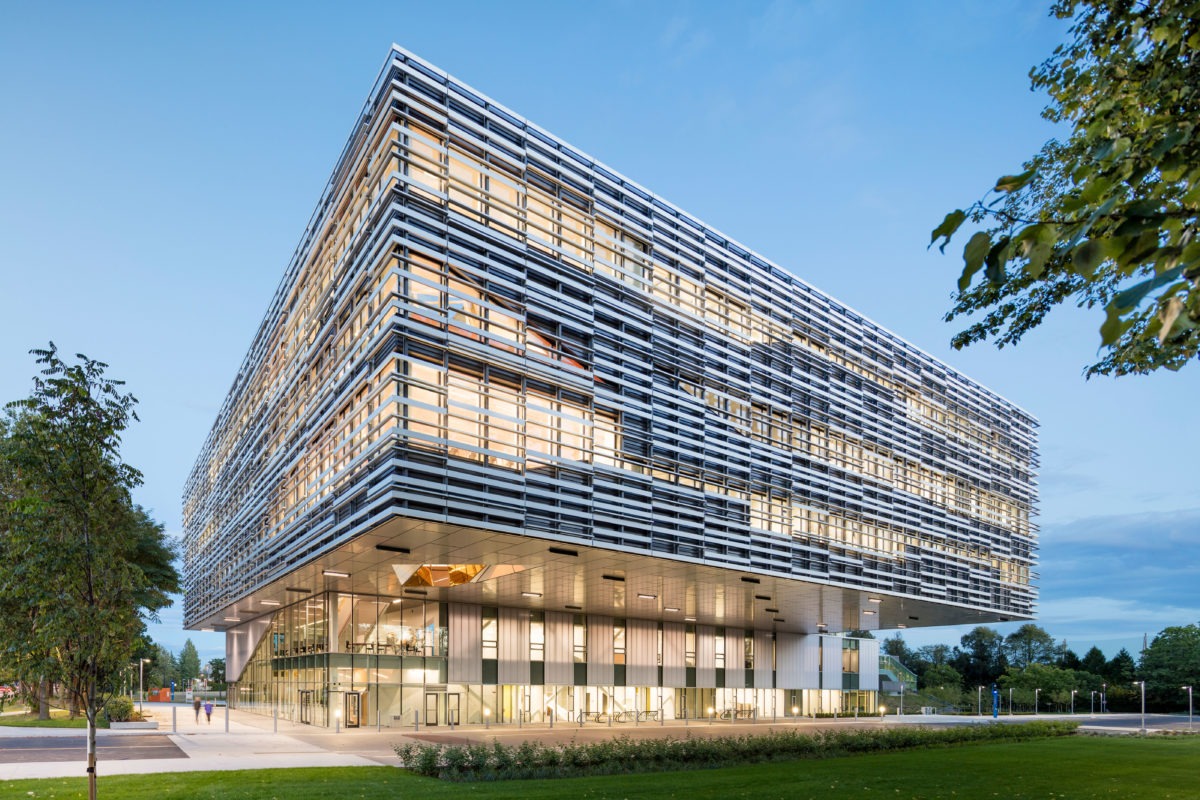
- Photo by Andrew Latreille
At Langara College in Vancouver, the multistory Vortex Lounge is an oculus shaped like a crystal, designed to bring as much light into the building as possible. The building also utilizes a light well, which brings in more daylight and passively moves air as it acts as a return air shaft, as well as a skylight on the west side of the building.
“The more natural light we can get to penetrate the building, the less ambient lighting we need to use, thereby reducing energy consumption. The challenge is controlling glare,” architect Kori Chan of Proscenium Architecture + Interiors Inc told gb&d. The solutions for this building: translucent panels on the lower floors and an architectural screen on the top three levels.
2. Andy Quattlebaum Outdoor Recreation Center at Clemson University
-
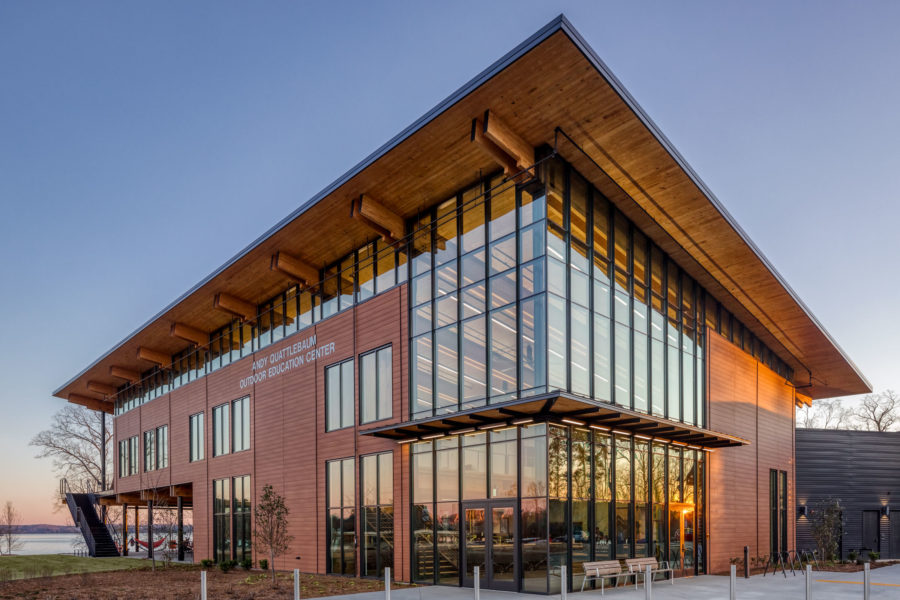
- The new Andy Quattlebaum Outdoor Recreation Center at Clemson University was designed by Cooper Carry in collaboration with Clemson University’s Wood Utilization + Design Institute. Photo by Jonathan Hillyer
At Clemson’s outdoor recreation center, a major priority was to support the mental health as well as physical health of students. As such, biophilic materials and natural light became focal points of the design.
Large, strategic windows collaborate with sensor-controlled lighting to brighten the space and conserve energy, while large fans and passive cooling serve to bring comfortable air to the recreation center.
3. Bloomberg’s European Headquarters
-
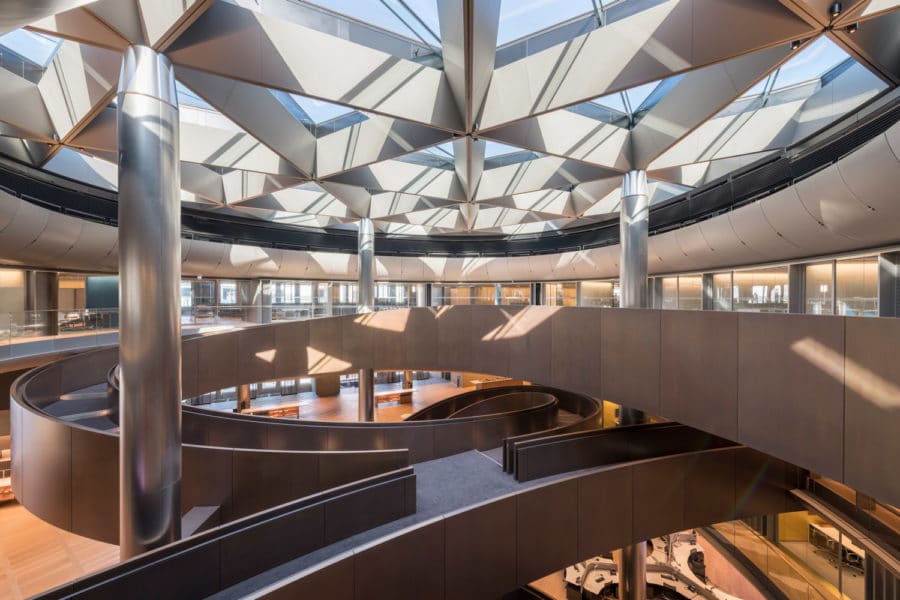
- Photo by Nigel Young / Foster+Partners
In the heart of London, Bloomberg’s solution for daylighting is comprehensive and complete, proving even a headquarters in the middle of a city known for its grayness and fog can be bright and pleasant indoors. A central atrium invites light and expels heat while the building’s windows are set into an exterior framework angled to maximize light and reduce direct sun exposure and glare. Breathable walls and petal-leaf aluminum ceiling tiles assist in the heating, cooling, and acoustics of the building while also reflecting and amplifying natural light, equipping the building with many technologies that help daylighting work at its best.
4. Studio Ma’s Xero Studio
-
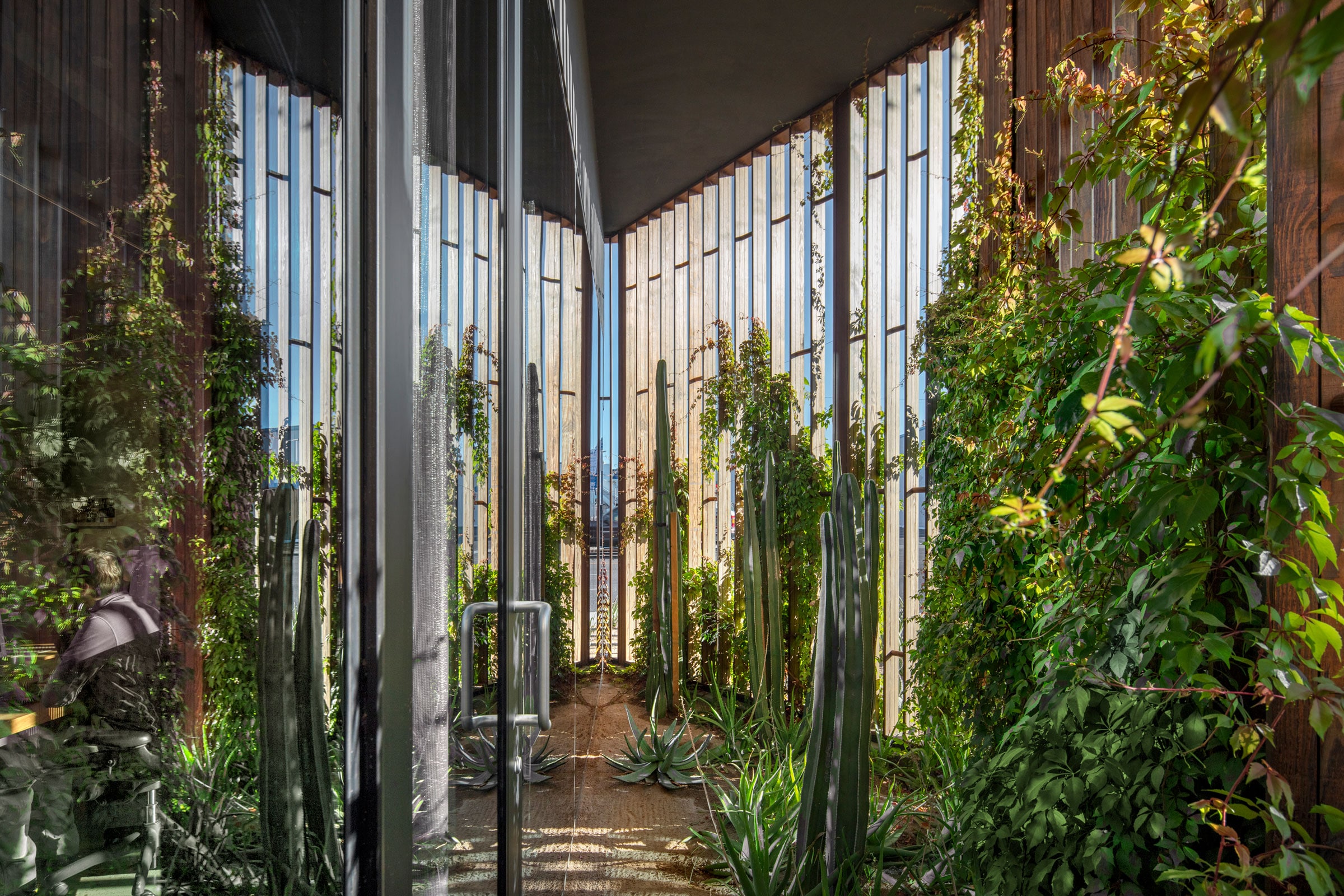
- Photo by Bill Timmerman
Studio Ma’s headquarters in Phoenix use daylighting for passive cooling as well as for natural ambience and views. The building is encased in a screen of kebonized wood that blocks direct sun to reduce heat gain and glare while still offering light and enhancing outdoor views for occupants. The mix of biophilic design and light makes the workplace bright and airy. Operable skylights offer additional light and expel heat for passive cooling.
5. Santa Monica City Services Building
-
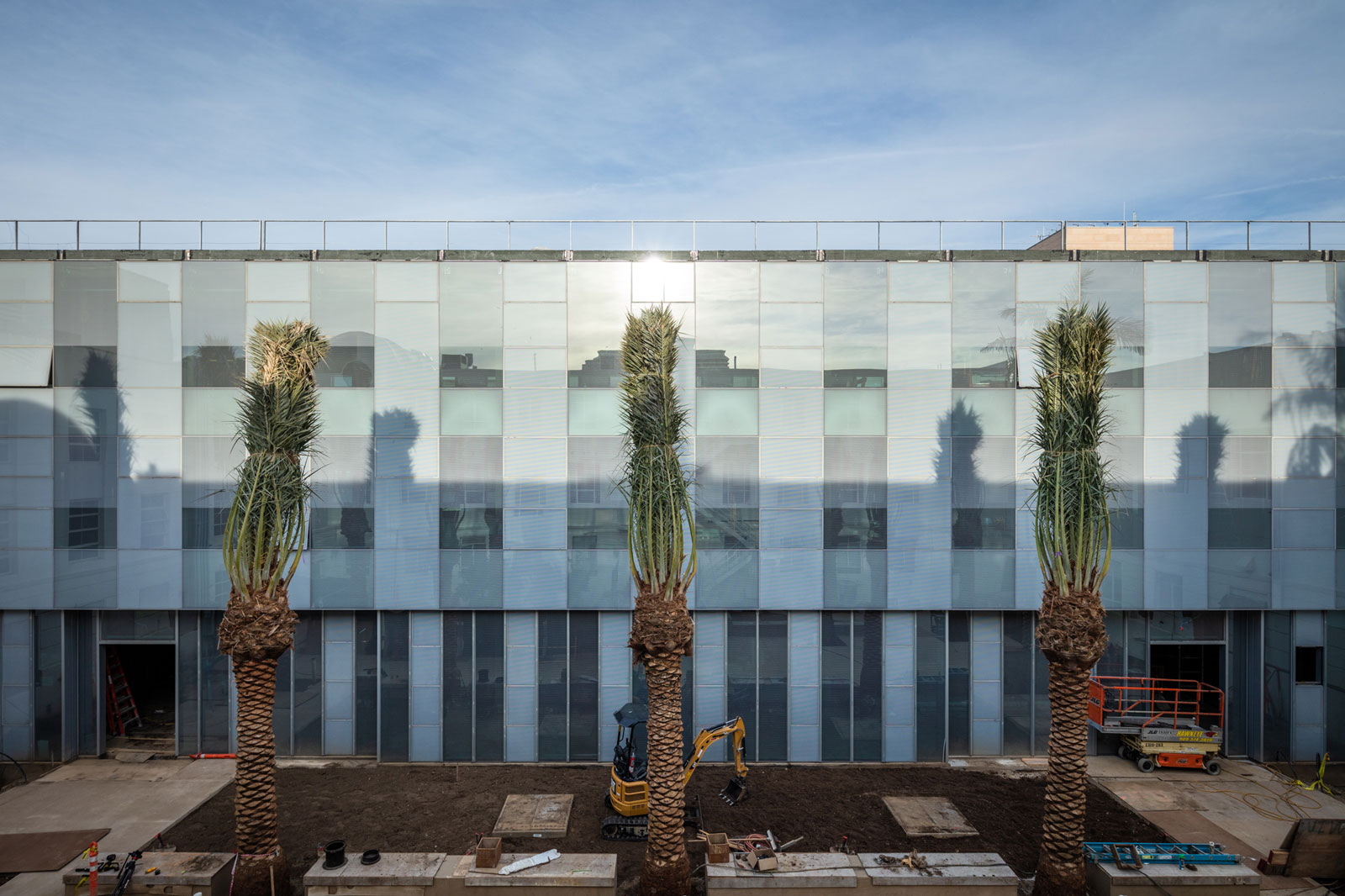
- Photo by Alex Nye
As the first municipal building to seek full Living Building Challenge certification, the Santa Monica City Services Building, engineered by Buro Happold, must incorporate daylight, air, nature, and community.
This building uses daylighting for heating and cooling as well as light, comfort, and air, with 209 operable windows that work with the Santa Monica climate to naturally ventilate the space. “The facade is working really hard to control heat gain. It’s heavily fritted, so it’s keeping a lot of the heat out,” says Julian Parsley, principal at Buro Happold. Fritted glass fuses ceramic frits to the glass’s surface to block a percentage of light and reduce heat gain and glare without reducing the positive effect inside.
6. UnityPoint Health – Prairie Parkway
-

- Photo by Corey Gaffer Photography
In this medical center, Prairie School architecture meets large-scale commercial architecture with floor-to-ceiling windows and blue glass accents that call back to Prairie-style stained glass.
Windows bring in heaps of golden light and comforting warmth while electronic lights equipped with daylight-sensors dim accordingly to reduce energy use. The windows bring openness and comfort along with views of the landscape outdoors to inspire wellness.
Laura Rote contributed to this article.

